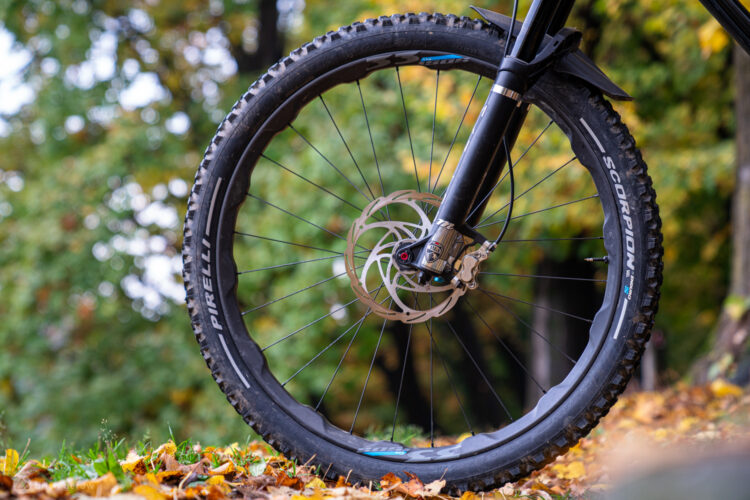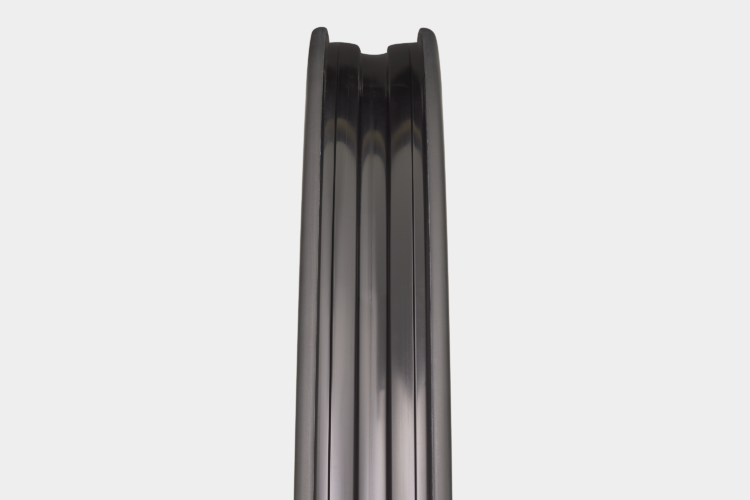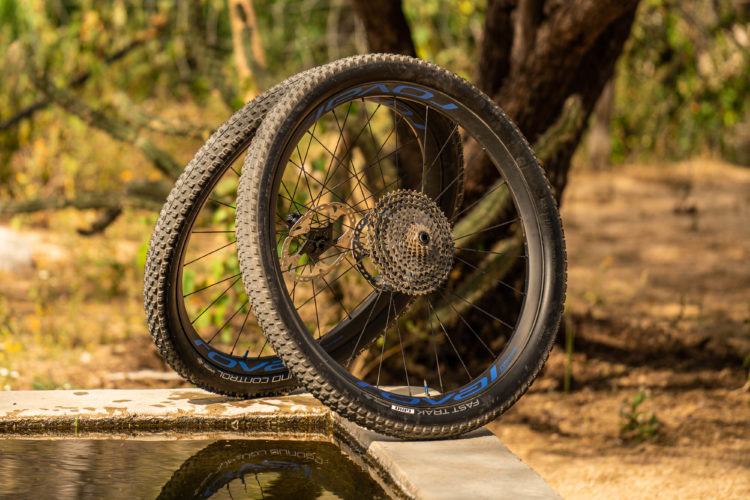
In bike reviews and press releases we often write about the “carbon wheels” that an extra fancy bike comes with. The storied powers that those glued fibers hold give the bike an elevated essence, and a price hike. In truth, there are very few fully carbon fiber bicycle wheels in the world. Brands like Topolino, Madfiber, and Syncros have taken a crack at fully carbon hoops in the past, with varied success.
As many of you know, what we mean when writing “carbon wheels” is that the wheel system uses carbon rims. The spokes are strings of steel, nipples are aluminum or brass, bearings are steel or ceramic with steel races and plastic seals, axles are often elongated steel or alloy cylinders, and most modern hub shells and freehub bodies are made of aluminum. From there, spoke lacing and butting, rim depth and width, bearing placement, and 300 other factors influence the way a wheelset performs. The phrase “carbon wheelset” is shorthand for “it’s complicated.”


I recently had the pleasure of testing Stans carbon-rimmed Flow CB7 wheelset on my Norco Torrent hardtail. If you’re in a hurry to skim the details I’ll save you some time. Priced at a reasonable $1,399 this 1804g gravity wheelset is a worthwhile upgrade for riders who are on the wheel upgrade hunt. The Flow CB7 add the stiffness and precision you expect from carbon rims without the proprietary build spec and crack-ability that accompany some of the competition. In case you do manage to fully case one of these rims, Stans offers an extensive warranty and crash replacement to back up their sturdy design. Now for the particulars.
I’ll kick off by stating that I hold high expectations of new Stans No Tubes goods. The company essentially made mountain biking more fun with the advent of their venerated tubeless sealant almost twenty years ago. That’s a tough act to follow.


The unique element of the Crest CB7 wheelset is its rim shape and updated freehub body. These are Stans first go at asymmetrical rims, and the tubeless compatibility and setup had to be perfect. Asymmetrical rims have the spoke holes drilled slightly to one side to allow for even spoke lengths on both sides despite the cassette and rotor placement — resulting in a more balanced and often times stronger wheel build.
The tricky bit for Stans was to design an asymmetrical rim with an internal bead seat or “ditch” that held the bead equally tight on either side. They experimented with a variety of shapes to achieve the Flow CB7 form, where the internal slopes reportedly take an equal amount of air pressure to lock the bead into place. That locking motion is important for proper tubeless setup, and possibly more crucial to keep the tire from “burping” or losing air on hard lateral compressions. Some asymmetrical rims can tend to burp more easily on one side than the other, and this was an element that the folks at Stans couldn’t accept.


I mounted up a sturdy 1,000g set of Onza Aquila 29 x 2.4 tires on the Flow CB7 rims that will be part of an “Aaron Gwin Approved” tire review in the near future. With a Nukeproof ARD insert in the rear tire and a healthy dollop of Tyre Yogurt in the pair, the tires set up as quickly and effortlessly as expected. After a few months of hot summer testing, the Tyre Yogurt remains thick and fluid, and the company says it can be scooped into another tire and used for the rest of the season. While I’m still happy to use Stans No Tubes sealant any day, it is great to see some newer companies doing things a little differently.
The ARD insert has some cuts where it saved my rear tire, rim, and ride, but it doesn’t seem to be sopping up the sealant quite yet. I will definitely leave it be for the remainder of the year. With zero punctures in these tires so far, I’m more than satisfied with how the sealant and insert have performed.
Twenty-nine millimeters is within the industry standard for gravity bike internal rim measurements these days, and the bulk of tire companies are designing casings accordingly. The Aquila tread set up nice and square above the CB7 rims, with just the right amount of corner-hugging curve.


I have had less than favorable experience with Stans Neo hubs in the past. The sets I have worked with on my own bikes and those of friends’ would blow through bearings quickly and were otherwise indistinguishable from much of the competition. While I haven’t ridden the wheels long enough to truly test the bearing life, this new set is rolling smooth and the bearings feel clean despite being mounted on my rainy-day bike. The latest Neo freehub has a third bearing to spread the axle load, which should contribute to longer-lasting bearings throughout.
| Price | $1,399 (available at REI) |
| Weight | 1804g in size 29″ with rim tape and valves installed |
| Recommended tire width | 2.35 – 2.80″ |
| Spokes | Sapim Force Black 2.0/1.7/1.8 spokes with Secure Lock aluminum nipples |
| Freehub options | SRAM XD, Shimano HG, Shimano MicroSpoline |
| Internal rim width | 29mm |
| Max rider weight | 250lbs (113 kilo) |
Trail talkin’
The updated Neo Ultimate Speed Sync freehub system is a massive improvement. The six pawls interact with 72 points of contact in the hub shell for a respectable 5° engagement. That’s a leap up from 10° with the original Neo hubs. It’s noticeable any time a climb becomes technical enough that fine crank movements are crucial to maintain forward momentum. In comparison, Shimano’s latest XTR freehub has 7.6° of engagement, so I’d say that the Neo is doing well for itself.
Without exception the Flow CB7 rims were good on their “no burp” tubeless guarantee. I have been running fairly low pressures at around 18-19PSI with these wheels so I could try to burp the tires on sideways compressions and crack the rims on stones. No Dice. The tires have read the same pressure at the end of every ride that they did at the beginning, and the rims are crack-free and dead-true. The stiff rims hold tight to the bead, locking it in on both sides to keep all of the air and sealant where it belongs.
Stans claims that their RiACT carbon rim construction method creates a circle with 3X the lateral stiffness of their aluminum rims, while providing up to 10mm of radial flex on impact. They state that “our carbon rims can deflect 7-10mm without damage or pinch flatting,” and I have yet to prove them wrong.
On the first few rides, I had the feeling that the wheels were too stiff. Harsh even. I soon realized that the Torrent frame is stiffer than other steel hardtails I’ve owned, and paired with the 37mm stanchioned Manitou Mezzer Pro fork I had simply over-stiffened the build. I mounted the wheels on my full suspension bike and they felt just right. I have since swapped in a smaller 31.8mm handlebar on the hardtail and the vibrations calmed significantly. Again, it’s not just carbon rims. It’s a whole system.
Fortunately, the Flow CB7 wheels hold their lateral shape affirmatively, no matter what bike they’re on. Whether carving deep in a berm or hoping for traction across off-camber roots, the lateral stiffness adds useful precision to the bike’s front end. Compared to the similarly shaped alloy DRC Bigfoot rims I was running on my full suspension setup previously, the CB7 gives the bike a more accurate cornering character. I am able to hold a line better on loose and rough trails than I could on some aluminum hoops.

While the CB7 wheels weren’t the main culprit in my overly rigid bike setup, they do feel a little less forgiving than some other carbon rims I’ve tested. The difference is subtle. I notice it because I get to ride 6-7 days per week on a variety of high-end wheels, but for most folks who enjoy trails on the weekend, these wheels will likely feel exactly how they expect carbon circles to feel.
My only other complaint, which is equally minor, is that the freehub has started to drag slightly and likely needs to be cleaned and re-greased. If I’m spinning a high cadence and stop all of a sudden I can feel (and watch) a tug on the drivetrain as the freehub takes a little extra time to stop spinning in lockstep with the wheel. While this will eventually happen with any freehub, it typically takes a full year or two of riding before a drag-dragon shows up and asks for a bath.
For the ultimate trail riding and enduro racing wheelset, I would prefer an aluminum rim under the saddle and a carbon rim beneath the handlebar. With that combo, you get all of the precision enhancing benefits up front where the rim is considerably less likely to break, and a more pliable and forgiving rim out back that can typically be straightened out should it be damaged on impact. For anyone who agrees, Stans Flow CB7 carbon rims are available à la carte for $600.
- Price: $1399
- Buy from REI





















0 Comments